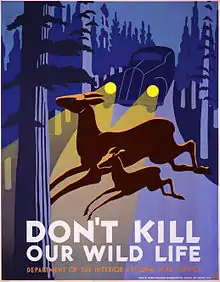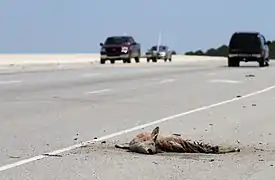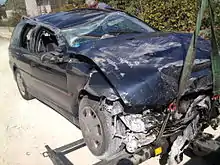Deer–vehicle collisions
A deer-vehicle collision occurs when one or more deer and a human-operated vehicle collide on a roadway. It can result in deer fatality, property damage, and human injury or death. The number of accidents, injuries, and fatalities varies from year to year and region. In the United States, an estimated 1.23 million deer related accidents occurred in a one-year period ending June 2012 (a 7.7 percent increase from the previous year), resulting in $900,305 in average property damage. The largest proportion of such accidents occur in November.[1]

In 2000, of the 6.1 million lightweight motor vehicle collisions in the US, 1 million involved animal-vehicle collisions. Deer–vehicle collisions lead to about 200 human deaths and $1.1 billion in property damage every year.[2] State and federal governments, insurance companies, and drivers spend an additional $3 billion in an effort to reduce and manage the increasing number of deer-vehicle collisions.[3] The term "deer-vehicle collision" is commonly annotated throughout safety agencies as DVC.
In Canada during the year 2000, there were nearly 29,000 animal-vehicle collisions resulting in property damage only, an additional 1,887 involving non-fatal injuries, and 23 fatal collisions.[4]
In Germany, over 220,000 traffic collisions occur annually involving deer, over 1000 of which lead to human injuries and around 20 to human fatalities.[5]
History of the deer
Deer–vehicle collisions have occurred since roadways have been built in close and direct proximity to direct habitat, also known as deer habitat fragmentation. White-tailed deer, the most common deer involved in deer-vehicle collisions, have steadily increased in numbers since the turn of the 20th century.[6] Currently, it is estimated that 20 to 30 million deer populate North America. The actual number of animals killed in deer-vehicle collisions is not known because no such database exists. In a 1981 study, it was concluded that "large animals," which included deer, accounted for 26% of animals killed each year in collisions with vehicles on interstates and country roads.[7]
The expansion and technological advances of roadways in the US have increased the number of deer-vehicle collisions.[6] The increased amount of habitat fragmentation, due to expanding technology, has increased the likelihood of a deer-vehicle collision.
In the United States, the state with the highest number of deer-vehicle collisions is Pennsylvania, with an estimated 115,000 collisions in 2013 causing $400 million in damage.[8] West Virginia is the state with the highest risk that a motorist will hit a deer whilst driving.[9]
Contributing factors

The main contributing factor of a deer-vehicle collision has been contested among studies and statistics. Many factors are yet to be identified or understood.[6] At this point, a main factor in all deer-vehicle collisions has not been concluded, but the most argued is the proximity of roadways to deer-populated forestry.[10] Significant factors also include: urban population and deer density. Also, studies have shown that, nationally, most deer vehicle collisions occur between May and November because of deer mating season and foraging before the winter months.[6]
Habitat fragmentation
Habitat fragmentation occurs when human technology encroaches upon the natural habitats of animals. As humans live in closer proximity to other animals, they are more likely to encounter one another. The most common type of habitat fragmentation across the United States is roadways and highways in forests and other deer-inhabited areas.[11] Because highways are isolated points of fragmentation, deer wander about them freely because they see little to stay away from.[12] Roadways and highways located in sparsely-populated areas are usually built along rivers and lakes of mountains and plains. These areas attract deer because they render safe havens and excellent foraging. Roadways and highways within densely populated deer habitat lead to more prevalent deer-vehicle collisions.
Time
A contributing factor to deer-vehicle collisions is the time of day at which motorists travel through deer habitation.[13] During the daytime, motorists can more easily see and avoid hitting deer. At night, most especially during the dusk and dawn hours, deer are much harder to see, which increases the chance of collision.
References
- "Top Five States For Deer-Related Collisions". State Farm. Retrieved 18 November 2015.
- Allan, William F, and Wells, Joann K. "Characteristics of Vehicle-Animal Crashes in Which Vehicle Occupants Are Killed." Traffic Injury Prevention 6 1 (2005) 56–59
- National Highway Traffic Safety Administration. Fatality Analysis Reporting System Data File. 2001–2002. http://www-fars.nhtsa.dot.gov.
- Communications, Government of Canada, Transport Canada, Safety and Security. "Statistical Review". www.tc.gc.ca. Retrieved 18 November 2015.
- "deer collisions project background".
- Hubbard, Michael W.; Danielson, Brent J.; Schmitz, Richard A. (2000). "Factors Influencing the Location of Deer-Vehicle Accidents in Iowa". The Journal of Wildlife Management. 64 (3): 707–713. doi:10.2307/3802740. JSTOR 3802740.
- Black, William R. Transportation: A Geographical Analysis. New York: Guilford Press (2003)
- "Report puts cost of car-deer crashes at $400 million in Pennsylvania". Pittsburgh Post-Gazette. 16 October 2013.
- "West Virginia again leads in deer collisions". Metro News. 7 October 2013.
- Farrell, Michael C.; Tappe, Philip A. (2007). "County-Level Factors Contributing to Deer–Vehicle Collisions in Arkansas". Journal of Wildlife Management. 71 (8): 2727–2731. doi:10.2193/2006-085. S2CID 84932199.
- Fulbright, Timothy E., Ortega, Alfonso. White Tailed Deer Habitat. Kingsville: Texas A&M.
- Alverson, William S.; Waller, Donald M.; Solheim, Stephen L. (1988). "Forests Too Deer: Edge Effects in Northern Wisconsin". Conservation Biology. 2 (4): 348–358. doi:10.1111/j.1523-1739.1988.tb00199.x.
- TransSafety Inc. "Deer-Vehicle Collisions are Numerous and Costly. Do Countermeasures Work?" Road Management & Engineering Journal. (1997)

